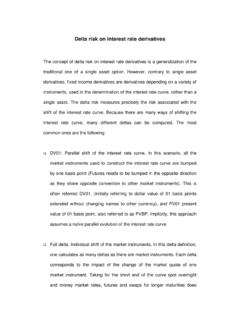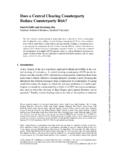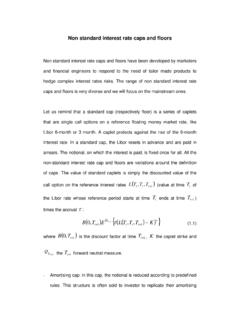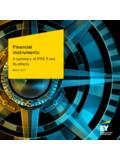Transcription of FRM - Foundations of Risk Management
1 FRM Foundations of Risk Management FRM - Foundations of Risk Management (Steven, CFA & FRM) Chapter 1 The Need for Risk Management Chapter 2 Risk Management Failures Chapter 3 Case Studies of Risk Management Chapter 4 Investors and Risk Management Chapter 5 Creating Value with Risk Management Chapter 6 Overview of Enterprise Risk Management (ERM) Chapter 7 Code of Conduct FRM Foundations of Risk Management Chapter 1 The Need for Risk Management 1. Concepts of risk Define risk and describe some of the major sources of risk y Definition of risk: - Risk is the volatility of unexpected outcomes. - Risk is the deviation from expected earnings (earnings volatility). y Sources of risk: - Human-created: business cycle, inflation, changes in government policies, wars.
2 - Unforeseen natural phenomena: weather and earthquakes. - Long-term economic growth: IT innovations can render existing technology obsolete and create dislocations in employments. Differentiate between business and financial risks and give examples of each y Types of risk: - Business risk: (i) Business decision: includes strategic risk, product development choices, capital expenditure decisions, marketing strategies. (ii) Business environment: competition and macroeconomic risk. Corporations assumes such risk willingly in order to create a competitive advantage and add to value for shareholders - Financial risk: Possible loss due to financial market activities. Describe the functions and purposes of financial institutions as they relate to financial risk Management y For corporations, they should concentrate on managing business risks (what they do best) and optimize the exposure to financial risks .
3 Y For financial institutions, the primary function is to manage financial risks actively, as the purpose of financial institutions is to assume, intermediate, or advise on financial risks . Financial institutions have to: - Understand financial risks , consciously plans for the consequences of adverse outcomes. - Measure financial risks precisely in order to control and price them properly. FRM Foundations of Risk Management Define and describe the four major types of financial risks : market, liquidity, credit, and operational Within market risk: Describe and differentiate between absolute and relative market risk Describe and differentiate between directional and non directional market risk Describe basis risk and its sources Describe volatility risk and its sources y Market risk: the risks of losses owing to movements in the level or volatility of market prices.
4 Absolute risk y Measure price movement in dollar terms. y Focus on the volatility of total return. Relative risk y Measure return change relative to benchmark index. y Focus on tracking error or deviation from the index. Directional risk Exposure to the direction of movement in financial variables or market prices. Nondirectional risk Remaining risks : a. Nonlinear risk b. Basis risk: Exposure to hedged position. It is created from unanticipated movements in the relative prices of assets in a hedged position. c. Volatility risk: Exposure to actual or implied volatility y Mitigation: Market risk is controlled by limits on notionals, exposures, VaR. Within liquidity risk: Describe and differentiate between asset and funding liquidity risk y Liquidity risk: Asset liquidity risk (Market liquidity risk, Product liquidity risk) y Definition: A transaction can t be conducted at prevailing market price due to the size of the position relative to normal trading lots.
5 Y This risk varies across asset categories, time, and size of the position. y Mitigation: Such risk can be managed by setting limits and by means of diversification. Funding liquidity risk (Cash-flow risk) y Definition: Inability to meet payments obligations, which may force early liquidation and thus transform papers losses into realized losses. y The risk is especially a problem for portfolios that are leveraged and subject to margin calls from lenders. y Mitigation: Such risk can be controlled by proper planning of cash-flow, by means of diversification and by the consideration of ways to raise new funds. y Death spiral: Funding liquidity risk interacts with asset liquidity risk. If cash reserves are insufficient for payment (Funding liquidity risk), we may suffer an involuntary liquidation of the portfolio at depressed prices (Asset liquidity risk).
6 FRM Foundations of Risk Management Within credit risk: Describe and differentiate between exposure and recovery rate Describe credit event and how it may relate to market risk Describe sovereign risk and its sources Describe settlement risk and its sources y Credit risk: Company-specific y Definition: The risk of losses that counterparty may be unwilling or unable to fulfill their contractual obligations. Credit risk is measured by the cost of replacing cash flows if counterparty defaults. y Credit loss encompasses the exposure (amount at risk) and the recovery rate (the proportion paid back to the lender). y Credit event vs. market risk: Credit risk can occur before the actual default. It is defined as potential loss in mark-to-market value due to the occurrence of a credit event ( change in counterparty s ability to perform its obligation, change in credit rating, change in market s perception of default).
7 Y Mitigation: Credit risk can be controlled by credit limits on nationals, current and potential exposures, credit enhancement (collateral or marked-to-market). Country-specific y Sovereign risk y Sources: - A government may be unwilling or unable to fulfill its contractual obligations. - A country imposes FX controls that makes it impossible for counterparty to honor its obligation. Settlement risk y A particular form of credit risk. y Sources: In the process of exchanging payments with the counterparty, the risk arises when the counterparty may default after the institution already made its payment. FRM Foundations of Risk Management Within operational risk: Describe the potential relationships between operational, market and credit risk Describe people risk Describe model risk and its sources Describe legal risk and its sources y Operational risk: - Definition: The risk of loss from failures or inadequacy in a company s systems, people or processes or from external events.
8 People risk y Sources: Internal fraud. y People risk is sometimes related to market risk. For example, rogue traders typically falsify their positions after incurring large market losses. - Operational risk can lead to market and credit risks . For example, an operational problem in a business transaction or a settlement fail can create market risk because the cost may depend on movements in market prices. - Operational risk also includes model risk and legal risk. Model risk y Sources: A part of inadequate internal process. Model risk emerges if we use flawed valuation model or misspecify model. y Mitigation: Model must be subjected to independent evaluation. Legal risk y Sources: Exposures to fines, penalties or punitive damages resulting from supervisory actions and private settlements.
9 Y Legal risk is generally related to credit risk. Counterparty who loses money on a transaction may try to find legal ground for invalidating the transaction. y Mitigation: Corporation s legal counsel develops policies in consultation with risk managers and senior Management . In addition, corporation should make sure that agreements with counterparties can be enforced before any deal is consummated. FRM Foundations of Risk Management 2. Derivatives and risk Management Relate significant market events of the past several decades to the growth of the risk Management industry y The recent growth of the risk Management industry can be traced directly to the increased volatility of financial markets since the early 1970s as below. The only constant across these events is their unpredictability.
10 1971 Fixed exchange rate system broke down, leading to flexible and volatile exchange rates 1973 Oil price shock accompanied by high inflation and wild swings in interest rates 1987 US stock collapsed 23%, wiping out $1 trillion on Oct 19 (Black Monday) 1989 Japanese stock-price bubble deflated and $ trillion capital lost, leading to an unprecedented financial crisis in Japan 1994 Fed started six consecutive interest rate hikes, erasing $ trillion in global capital 1997 Asia turmoil wiped out about 75% of dollar capitalization of equities in Indonesia, Korea, Malaysia and Thailand 1998 Russian default sparked a global financial crisis and a near failure of LTCM 2001 A terrorist attack in WTC caused horrendous human cost and $ trillion loss in US stock market 2007~ US sub-prime event and resulting credit crunch and global financial crisis Define what a derivative contract is and how it differs from a security y Definition of derivatives.





